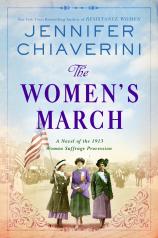The Women's March: A Novel of the 1913 Woman Suffrage Procession
Review
The Women's March: A Novel of the 1913 Woman Suffrage Procession
For years, I have been waiting for an engaging and comprehensive story about the women's suffrage movement. So I am happy to report that New York Times bestselling author Jennifer Chiaverni absolutely nails it with her latest release, THE WOMEN’S MARCH.
Based on three real-life suffragettes living in the United States in the early 1900s --- Alice Paul, Ida B. Wells-Barnett and Maud Malone --- this novel provides a detailed and fascinating account of how arduous and difficult it was for women to secure the right to vote. Even though a federal amendment granting women the right to vote was first proposed in 1878, it was not passed until 1920.
Alice was born in the United States but began her suffragette career in England and Scotland. After being arrested and held in terrible conditions, she returned home to recover her strength. She took up the cause on her home soil and eventually planned the grand 1913 women's suffrage parade.
"THE WOMEN’S MARCH is an often brutal and raw look at both sexism and racism, yet it also provides a beautiful and bright ray of hope."
Ida, a Black civil rights activist, journalist and married mother of four, focused her efforts on encouraging Black women to participate in the movement.
Maud, a New York City librarian and a leader of the movement, was known for her bipartisanship. She loved to “heckle” presidential candidates by asking their thoughts on women's suffrage.
Throughout four decades of rallies and protests, the women faced many adversaries who sorely underestimated their determination, perseverance and tenacity.
Of course, no movement is free of disagreement, even among those fighting for the same cause. This time, there was dissension as to whether or not Black women should be allowed to participate in the parades. Would letting them march mean losing support from Southern women? Or should the focus remain on securing equal voting rights for all women regardless of race?
Despite the serious topic, I loved that Chiaverini included intelligent zingers from each of the three women. The unexpected humor interjected by these outspoken ladies took me by surprise, causing me to laugh out loud numerous times.
My favorite parts of the book occurred when the women traveled 250 miles from New York City to Washington, DC in the cold March 1913 weather to participate in the Woman Suffrage Procession. I felt honored and privileged to join their ranks, albeit from my couch, and I could feel their joy and jubilation (and, unfortunately, their trepidation and fear at times) as they marched through the streets together chanting, “Votes for women!”
THE WOMEN’S MARCH is an often brutal and raw look at both sexism and racism, yet it also provides a beautiful and bright ray of hope. Thank you to Jennifer Chiaverini for penning the book I have been waiting for. I could not be more pleased, and I implore my fellow readers to march to the bookstore now to pick up a copy.
Reviewed by Rebecca Wasniak on July 30, 2021
The Women's March: A Novel of the 1913 Woman Suffrage Procession
- Publication Date: June 14, 2022
- Genres: Fiction, Historical Fiction, Women's Fiction
- Paperback: 368 pages
- Publisher: William Morrow Paperbacks
- ISBN-10: 0062976028
- ISBN-13: 9780062976024




